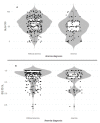Case-Control Analysis of the Impact of Anemia on Quality of Life in Patients with Cancer: A Qca Study Analysis
- PMID: 34063886
- PMCID: PMC8196564
- DOI: 10.3390/cancers13112517
Case-Control Analysis of the Impact of Anemia on Quality of Life in Patients with Cancer: A Qca Study Analysis
Abstract
Anemia is a common condition in cancer patients and is associated with a wide variety of symptoms that impair quality of life (QoL). However, exactly how anemia affects QoL in cancer patients is unclear because of the inconsistencies in its definition in previous reports. We aimed to examine the clinical impact of anemia on the QoL of cancer patients using specific questionnaires. We performed a post-hoc analysis of a multicenter, prospective, case-control study. We included patients with cancer with (cases) or without (controls) anemia. Participants completed the European Organization for Research and Treatment of Cancer Quality of Life questionnaire version 3.0 (EORTC QLQ-C30) and Euro QoL 5-dimension 3-level (EQ-5D-3L) questionnaire. Statistically significant and clinically relevant differences in the global health status were examined. From 2015 to 2018, 365 patients were included (90 cases and 275 controls). We found minimally important differences in global health status according to the EORTC QLQ-C30 questionnaire (case vs. controls: 45.6 vs. 58%, respectively; mean difference: -12.4, p < 0.001). Regarding symptoms, cancer patients with anemia had more pronounced symptoms in six out of nine scales in comparison with those without anemia. In conclusion, cancer patients with anemia had a worse QoL both clinically and statistically.
Keywords: anaemia; neoplasm; quality of life.
Conflict of interest statement
L.J.-P. reports personal fees from Bayer Hispania, personal fees from Actelion, personal fees from Pfizer, personal fees and non-financial support from Rovi, grants, personal fees and non-financial support from LEO Pharma, personal fees and non-financial support from Daiichi Sankyo, personal fees from Menarini, grants, personal fees and non-financial support from MSD, and non-financial support from Roche, outside of the submitted work. A.J.M.-M. reports personal fees and non-financial support from Celgene, grants and personal fees from Sanofi, personal fees from Pfizer, personal fees from Bristol-Myers Squibb, grants and personal fees from LEO Pharma, personal fees from Daiichi Sankyo, personal fees from Halozyme, personal fees from Rovi, non-financial support from Merck Serono, and non-financial support from Roche, outside of the submitted work. Other intellectual property: Risk assessment model for venous thromboembolism in patients with cancer. The authors declare no conflict of interest.
Figures

Similar articles
-
A Case-Control Analysis of the Impact of Venous Thromboembolic Disease on Quality of Life of Patients with Cancer: Quality of Life in Cancer (Qca) Study.Cancers (Basel). 2019 Dec 26;12(1):75. doi: 10.3390/cancers12010075. Cancers (Basel). 2019. PMID: 31888065 Free PMC article.
-
Internal Responsiveness of EQ-5D-5L and EORTC QLQ-C30 in Dutch Breast Cancer Patients during the First Year Post-Surgery: A Longitudinal Cohort Study.Cancers (Basel). 2024 May 21;16(11):1952. doi: 10.3390/cancers16111952. Cancers (Basel). 2024. PMID: 38893073 Free PMC article.
-
Health-related quality of life in patients with microsatellite instability-high or mismatch repair deficient metastatic colorectal cancer treated with first-line pembrolizumab versus chemotherapy (KEYNOTE-177): an open-label, randomised, phase 3 trial.Lancet Oncol. 2021 May;22(5):665-677. doi: 10.1016/S1470-2045(21)00064-4. Epub 2021 Apr 1. Lancet Oncol. 2021. PMID: 33812497 Clinical Trial.
-
Psychometric validation of the Moroccan version of the EORTC QLQ-C30 in colorectal Cancer patients: cross-sectional study and systematic literature review.BMC Cancer. 2021 Jan 27;21(1):99. doi: 10.1186/s12885-021-07793-w. BMC Cancer. 2021. PMID: 33499819 Free PMC article.
-
Validated Instruments of Quality of Life (QOL) in Patients With Acute Myeloid Leukemia (AML) and Other Cancers.Front Pharmacol. 2020 Jul 24;11:1109. doi: 10.3389/fphar.2020.01109. eCollection 2020. Front Pharmacol. 2020. PMID: 32792948 Free PMC article. Review.
Cited by
-
Reinitiating Chemotherapy beyond Progression after Maintenance Immunotherapy in Extensive-Stage Small-Cell Lung Cancer.Medicina (Kaunas). 2024 Jul 28;60(8):1225. doi: 10.3390/medicina60081225. Medicina (Kaunas). 2024. PMID: 39202506 Free PMC article.
-
Transcranial versus Direct Cortical Stimulation for Motor-Evoked Potentials during Resection of Supratentorial Tumors under General Anesthesia (The TRANSEKT-Trial): Study Protocol for a Randomized Controlled Trial.Biomedicines. 2021 Oct 16;9(10):1490. doi: 10.3390/biomedicines9101490. Biomedicines. 2021. PMID: 34680607 Free PMC article.
-
Exploring the gut microbiome's influence on cancer-associated anemia: Mechanisms, clinical challenges, and innovative therapies.World J Gastrointest Pharmacol Ther. 2025 Jun 5;16(2):105375. doi: 10.4292/wjgpt.v16.i2.105375. World J Gastrointest Pharmacol Ther. 2025. PMID: 40575364 Free PMC article.
References
-
- Stevens G.A., Finucane M.M., De-Regil L.M., Paciorek C.J., Flaxman S.R., Branca F., Peña-Rosas J.P., Bhutta Z.A., Ezzati M. Global, regional, and national trends in haemoglobin concentration and prevalence of total and severe anaemia in children and pregnant and non-pregnant women for 1995-2011: A systematic analysis of population-representative data. Lancet Glob. Health. 2013;1:16–25. doi: 10.1016/S2214-109X(13)70001-9. - DOI - PMC - PubMed
-
- Horton S., Ross J. The economics of iron deficiency. Food Policy. 2003;28:51–75. doi: 10.1016/S0306-9192(02)00070-2. - DOI
-
- Alcázar L. The economic impact of anaemia in Peru. Lima: Group for the Analysis of Development and Action Against Hunger. Animal Genetics. 2013;39:561–563.
-
- De Benoist B., Mclean E. Worldwide Prevalence of Anaemia 1993–2005 Who Global Database on Anaemia. World Health Organization; Geneva, Switzerland: 2008.

